To craft a personalized recipe book for a family reunion, gather cherished family recipes, stories, and heirlooms that reflect your heritage. Choose a format that suits your needs and design it with your family’s style in mind. Organize recipes with clear categories, add personal touches like photos and anecdotes, and consider digital tools or professional printing options. If you keep exploring, you’ll discover more tips to create a meaningful family keepsake.
Key Takeaways
- Incorporate family anecdotes, heirlooms, and cultural stories to personalize the recipe book’s content and deepen family connections.
- Choose a suitable format and design with family photos, themed layouts, and personalized covers for a meaningful presentation.
- Organize recipes by categories and include indexes or tabs to facilitate easy navigation during family gatherings.
- Use cohesive color schemes, clear typography, and visual elements that reflect family traditions and warmth.
- Consider durable binding and printing options, and plan for regular updates with new recipes and family stories to maintain relevance.
Gathering Family Recipes and Stories
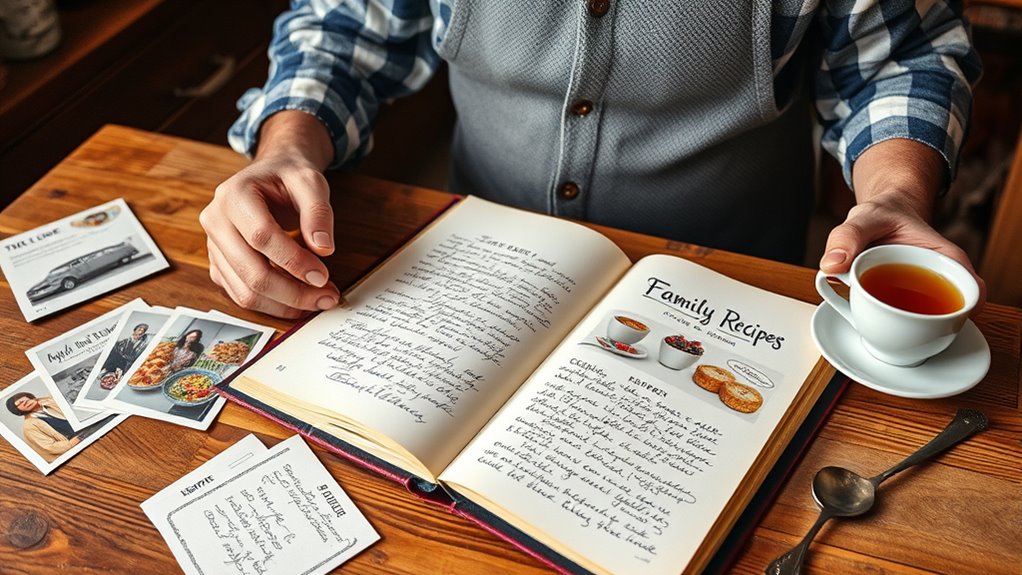
Gathering family recipes and stories is a meaningful way to connect with your heritage and preserve your loved ones’ traditions. Start by collecting family anecdotes that reveal the history behind favorite dishes or special occasions. Talk to relatives about their cooking traditions, asking them to share memories tied to certain recipes. These stories add depth and personality to your recipe book, making it more than just a collection of instructions. As you gather recipes, pay attention to the unique techniques or ingredients passed down through generations. Documenting these details preserves the cultural significance behind each dish, allowing future generations to feel connected to their roots. Incorporating family health history into your collection can also help engage family members and encourage participation. This process not only keeps traditions alive but also creates a meaningful family legacy. Additionally, understanding cultural food practices can enrich your collection and provide context for the recipes.
Selecting the Right Format and Design
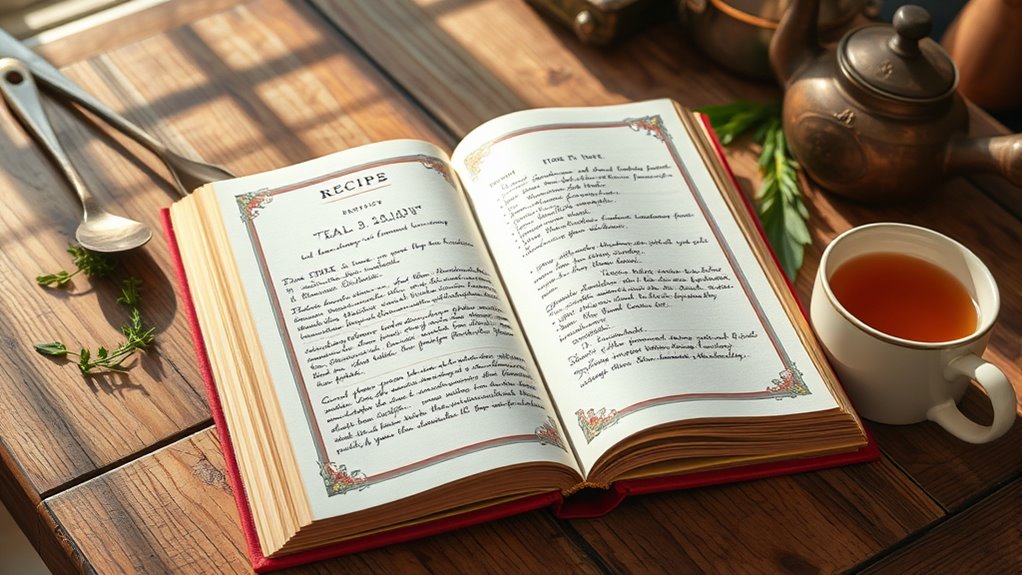
Choosing the right format and design helps your recipe book stand out and reflect your style. Consider different format options and styles to find what best suits your needs, and think about visual appeal and layouts that make recipes easy to follow. Don’t forget to explore personalization features that add a special touch to your book. Additionally, paying attention to drivetrain components such as the layout and font choices can enhance readability and overall presentation. Incorporating rustic decor elements can also reinforce the farmhouse theme and make your recipe book more charming. Being mindful of proper storage techniques can ensure your recipes and personal touches stay pristine over time.
Format Options and Styles
When selecting the right format and design for your personalized recipe book, it’s essential to think about how you plan to use it and who will be reading it. Your choices of font choices and color schemes set the tone. Imagine flipping through pages with clear, easy-to-read fonts that match your family’s style. Consider vibrant color schemes that highlight favorite recipes or special occasions. Think about:
- A hardcover for durability and a polished look.
- Spiral binding for easy laying flat while cooking.
- Elegant fonts paired with warm, inviting colors to evoke nostalgia.
- Incorporating interior design elements can inspire a cozy, homey atmosphere in your kitchen or dining space, adding a touch of greenery to complement your culinary creations. This can also serve as a metaphor for blending different styles and functions to create a unique and personal keepsake.
These decisions will influence how your family interacts with the book. Focus on a style that reflects your family’s personality and makes everyone want to explore those treasured recipes.
Visual Appeal and Layouts
To create a visually appealing and well-organized recipe book, focus on layout elements that draw the reader in and make recipes easy to follow. Choose a cohesive color scheme that enhances readability and reflects your family’s personality—soft pastels or bold contrasts can set the tone. Pay close attention to typography choices; select fonts that are clear and legible, with variations for headings and body text to create visual hierarchy. Consistent spacing, margins, and alignment help keep the pages clean and inviting. Incorporate images or icons sparingly to highlight sections or special recipes without cluttering the layout. Remember, a balanced design with thoughtful color schemes and typography choices will make your recipe book both attractive and functional. Additionally, integrating textured fabrics and other decor elements inspired by farmhouse style can add visual interest and warmth to your presentation, making it more engaging for readers. Considering entertainment and parks themes for design elements can also infuse a sense of fun and nostalgia, enhancing the overall appeal of your personalized cookbook.
Personalization Features
Selecting the right format and design for your personalized recipe book begins with understanding how you want to use and share it. Think about how recipe branding will influence the look—whether through custom covers or themed layouts. Consider dietary customization options, such as sections for gluten-free or vegetarian dishes, to make it inclusive. Visualize your options:
- A hardcover book with personalized titles and family photos
- A digital version with interactive features and customizable categories
- A spiral-bound collection for easy flipping and updating
These choices help you tailor the book to your family’s preferences, making it a meaningful keepsake. Choosing the right format guarantees your recipes are both functional and personal, creating a treasured family heirloom. Incorporating personalization features like custom covers and themed layouts ensures your recipe book reflects your family’s unique style and traditions. Additionally, understanding the differences between pen testing and ethical hacking can inspire you to consider different approaches to customizing and securing your digital recipe collection, ensuring it remains private and well-protected. Ensuring your digital files are stored in secure, eco-friendly options can also help promote sustainable practices while safeguarding your cherished recipes.
Organizing Recipes for Easy Navigation
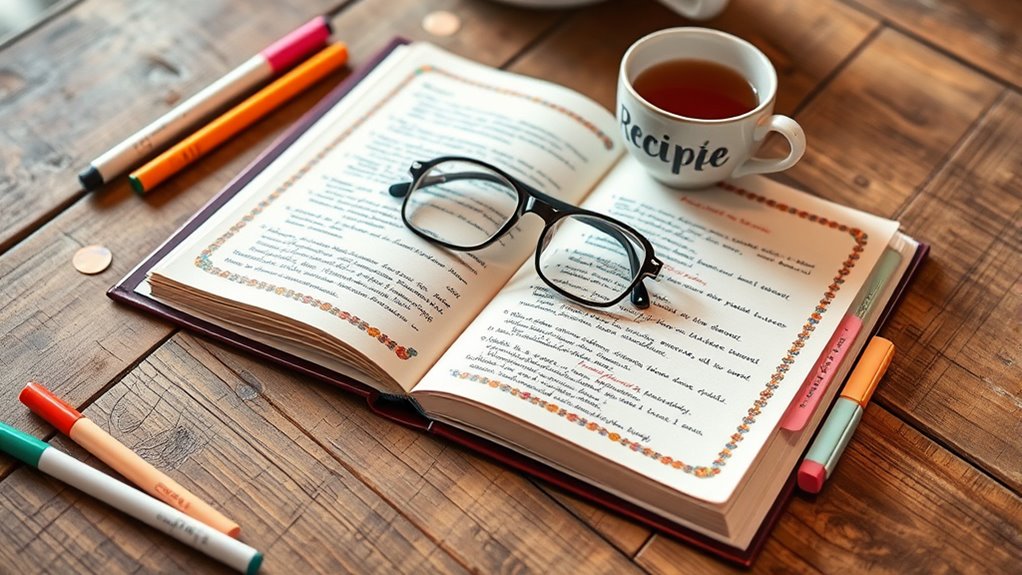
Organizing your recipes effectively makes it much easier to find what you need quickly. Start by using indexing techniques that allow you to locate recipes at a glance, such as alphabetical or thematic labels. Categorization methods are essential—group recipes by meal type, main ingredient, or occasion. Create clear sections or tabs in your recipe book to streamline navigation. Consider using color-coding for different categories to enhance visual cues. Consistent labeling guarantees recipes are easy to locate, saving you time during meal prep. Keep similar dishes together, and include an index or table of contents at the front for quick reference. Well-organized recipes make your family reunion meal planning smoother and more enjoyable, letting you focus on sharing good times rather than hunting for recipes.
Incorporating Personal Touches and Photos
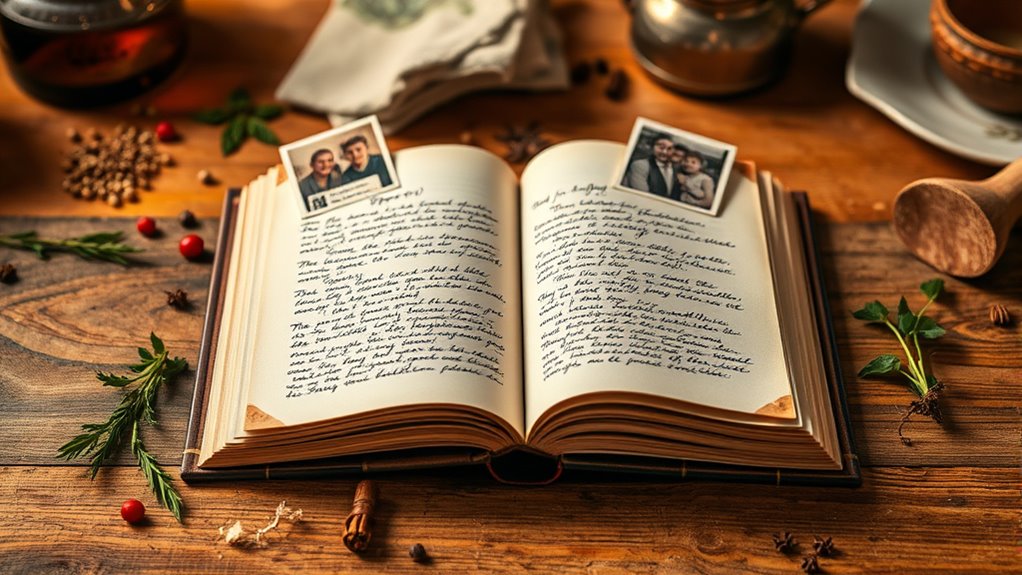
Have you ever thought about how personal touches and photos can transform a simple recipe book into a cherished keepsake? Including family anecdotes alongside recipes brings warmth and character, connecting everyone through shared stories. To enhance your book, consider these elements:
- Family Photos: Insert pictures of loved ones cooking or enjoying dishes, creating visual memories.
- Culinary Traditions: Highlight unique family recipes that reflect your heritage, emphasizing their importance.
- Personal Notes: Add handwritten comments or tips that reveal special moments or cooking secrets passed down through generations.
- Incorporating automation technologies in your organization or project can streamline the process of creating and sharing personalized recipe books. Recognizing the significance of soulmate angel numbers can inspire a sense of connection and purpose in your family gatherings, making your recipe book even more meaningful. Additionally, applying SSD organization tips for audio production can help you manage digital files like scanned recipes and photos efficiently, ensuring easy access when compiling your book.
Using Digital Tools and Templates

Choosing the right digital tools makes creating your recipe book much easier. Look for user-friendly platforms that guide you through customization without hassle. With the right templates, you can personalize your book quickly and make it truly unique. Incorporating diverse genres can also add a creative touch to your collection, making it more engaging for family members. Selecting tools that support customization options ensures your recipes are presented in a way that reflects your family’s style and preferences. Additionally, understanding juice cleansing and its effects can inspire themed sections or wellness tips within your recipe collection.
Choosing User-Friendly Platforms
Selecting the right digital tools and templates is essential for creating personalized recipe books that are easy to use and share. To find the best fit, consider platform comparisons focused on user interface, which directly impacts ease of navigation. Think of these options: 1. A platform with a clean, intuitive layout that guides you effortlessly through the design process. 2. Tools that offer drag-and-drop features, simplifying customization without technical skills. 3. Templates that are adaptable, allowing you to tailor layouts to your family’s style. 4. Also, review the platform’s privacy policy to ensure your personal data and family recipes are protected during the design process. Additionally, choosing a platform with high contrast ratio can improve readability of your printed or digital recipe book, making it more accessible for all family members.
Customizing Templates Effectively
Once you’ve found a platform with user-friendly templates, the next step is to customize them to reflect your personal style and needs. Start by selecting fonts that match the tone of your recipe book—whether casual, elegant, or fun. Pay attention to font size and readability, especially for recipes you’ll reference often. Next, choose color schemes that complement your theme or family’s preferences; consistent, harmonious colors make the book visually appealing. Use contrasting colors for headings and body text to improve clarity. Don’t overdo it—simplicity often works best. Adjusting font selection and color schemes allows you to create a cohesive, personalized look that makes your recipe book unique and enjoyable for everyone at your family reunion. Incorporating elements like visual balance can enhance overall aesthetic harmony, especially when considering butter making themes that evoke tradition and warmth.
Printing and Binding Your Custom Book

When you’re ready to bring your personalized recipe book to life, the printing and binding process transforms your digital files into a durable, professional-looking keepsake. Choose from various printing options, such as digital or offset printing, to guarantee vibrant colors and sharp text. Next, consider binding techniques that suit your style and durability needs. Common options include spiral binding, perfect binding, or hardcover binding, each offering a different aesthetic and strength.
- Imagine flipping through pages bound with a sleek spiral, laying flat for easy cooking.
- Visualize a polished hardcover, giving your collection a lasting, elegant finish.
- Think of the sturdy perfect binding, resembling a professional cookbook.
These choices turn your digital project into a keepsake you’ll cherish for years.
Sharing and Distributing the Recipe Collection
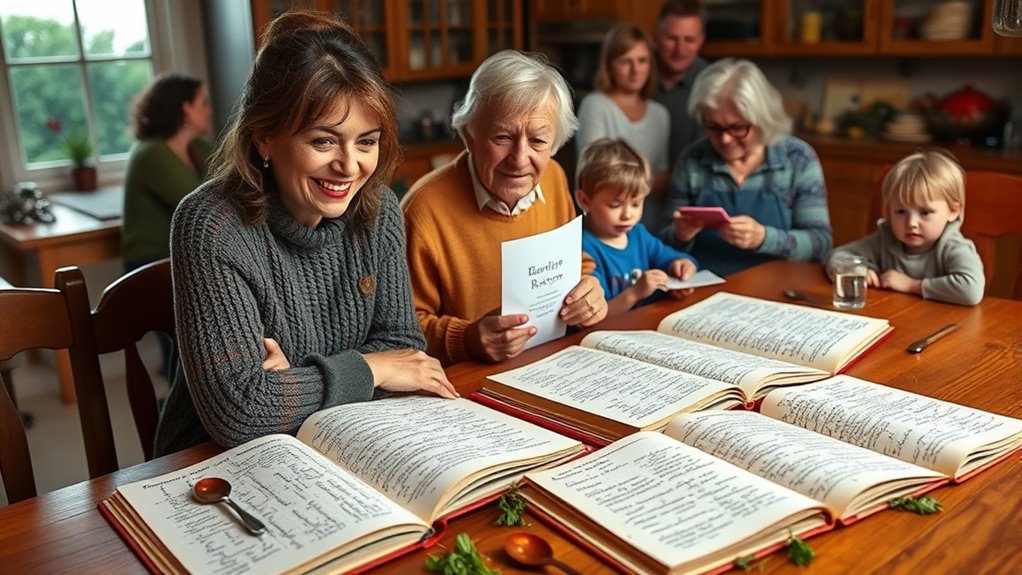
Sharing and distributing your personalized recipe collection allows you to spread your culinary creations with friends, family, or a wider audience. By doing so, you celebrate cultural traditions and keep them alive across generations. Consider creating themed copies centered on seasonal themes, such as holiday feasts or summer barbecues, to make each edition special. Digital sharing through email or social media makes it easy for loved ones to access and enjoy these recipes anytime. If you prefer a tangible approach, distribute printed copies at family gatherings or community events. This not only fosters connection but also encourages others to contribute their own recipes or stories. Ultimately, sharing your collection helps preserve family heritage while inspiring new culinary traditions.
Preserving and Updating the Recipe Book Over Time
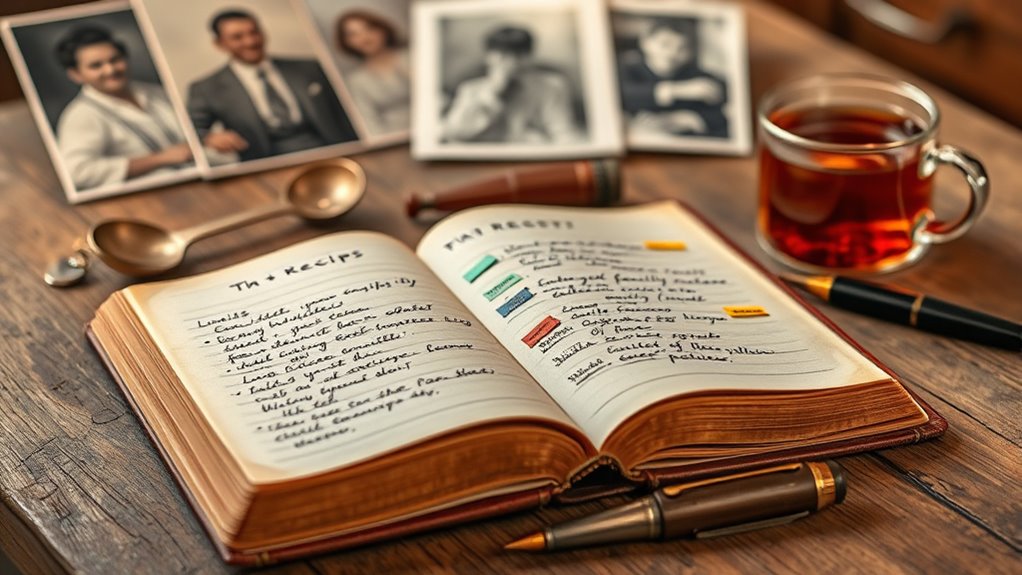
To keep your recipe book meaningful and relevant, it’s essential to regularly maintain and update it over time. Using effective recipe update strategies ensures your collection stays fresh and personal. Imagine adding a new family favorite, updating a recipe with fresh notes, or including recent family anecdotes that highlight special moments. Here are some ways to do this:
- Schedule annual reviews to incorporate new recipes and updates.
- Keep a dedicated section for preserving family anecdotes alongside each dish.
- Digitize your book for easy editing and sharing.
Frequently Asked Questions
How Can I Encourage Reluctant Family Members to Share Recipes?
To encourage reluctant family members to share recipes, you can emphasize family storytelling and create recipe sharing incentives. Show how their stories add value, making the recipes more meaningful. Offer small rewards or recognition to motivate participation, and keep the process fun and informal. By highlighting the importance of family history and making sharing easy, you’ll inspire even the shyest members to contribute their cherished recipes.
What Are Cost-Effective Options for Printing Large Quantities of Recipe Books?
Sure, because nothing says budget-friendly like expensive printing. For large quantities, bulk printing is your best bet, offering significant discounts per unit. Combine that with DIY binding to save even more on costs. You’ll get professional-looking books without breaking the bank, making it easy to share family recipes at reunions without draining your wallet. Who knew that simplicity and volume could go hand in hand?
How Do I Ensure Recipes Remain Accurate and Consistent Over Time?
To keep recipes accurate and consistent over time, focus on recipe standardization by clearly listing ingredient amounts and preparation steps. Regularly review and update recipes to reflect any ingredient sourcing changes. You should also document preferred ingredient brands or substitutes, ensuring everyone involved maintains the same standards. This approach helps preserve the integrity of each recipe, making your family reunion recipe books reliable and enjoyable for years to come.
What Copyright Considerations Should I Be Aware of When Including Family Stories?
Thinking about copyright concerns is like walking a tightrope; you want to honor family story rights without crossing legal lines. When including family stories, you should get explicit permission from the storytellers or confirm stories are in the public domain. Be cautious with copyrighted material and consider adding a disclaimer. Respect and clear consent safeguard your project from potential legal pitfalls, keeping your family history both heartfelt and lawful.
How Can I Incorporate Dietary Restrictions or Modern Adaptations Into Traditional Recipes?
You can incorporate dietary restrictions or modern adaptations into traditional recipes by suggesting gluten-free substitutions, like almond flour instead of wheat flour, or offering vegan adaptations by replacing eggs with flaxseed or applesauce. Encourage your family members to share their preferences and experiment with ingredient swaps to make each recipe inclusive. This way, everyone can enjoy the dishes, honoring tradition while accommodating modern dietary needs.
Conclusion
Now, with your personalized recipe book in hand, you’re weaving a tapestry of family history—each page a vibrant thread connecting generations. It becomes more than just a collection of recipes; it’s a living storybook, bursting with memories and flavors. As you share it at reunions, watch how it sparks conversations and rekindles bonds. Your creation turns into a treasured heirloom, a delicious legacy that will nourish both bellies and hearts for years to come.









